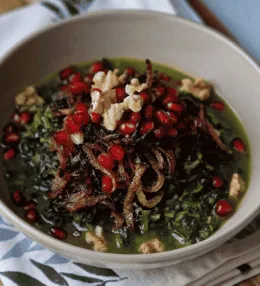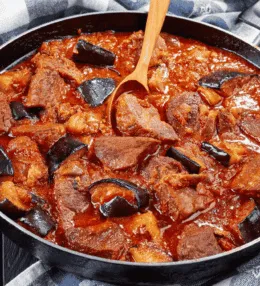
- View
Table of Contents
ToggleBicol Express is a Filipino dish that wears its character proudly. Known for its fiery heat and creamy coconut base, it stands out as a meal that delivers both strength and comfort in equal measure. It is deeply associated with the Bicol region, where spice is celebrated.
This is food that is not shy. The first taste is rich and mellow with coconut, then the chilli makes itself known, slow at first and then full. Every mouthful balances creaminess with a heat that lingers, making it an unforgettable part of Filipino cuisine.
It is a dish that can be found everywhere from family kitchens to local eateries. Even with its bold personality, there is a warmth to Bicol Express that speaks of home and hospitality, traits deeply woven into the food culture of the Philippines.
Want to dive deeper into Filipino Cuisine? Don’t miss our post on 28 Traditional Filipino Foods to Try
What Is Bicol Express?
Bicol Express is a slow cooked stew made with pork simmered in coconut milk with a generous amount of fresh chillies. Shrimp paste adds a savoury depth to the sauce, which clings to every piece of meat, giving the dish its full and complex flavour.
Although pork is the usual choice, versions with seafood or vegetables also exist. It is often served with plain white rice, the simplicity of the rice helping to soften the dish’s heat and allowing the full flavour of the sauce to come through.
Bicol Express is meant to be eaten in good company. It is a dish that is passed around the table, ladled over rice, and enjoyed with the casual confidence of food that knows exactly who it is and where it comes from.
Ingredients and Taste
The dish begins with pork cut into bite sized pieces. These are cooked gently in coconut milk, sometimes with a little cream, until tender. Chillies, both green and red, are added generously, giving the stew its signature fiery kick.
Shrimp paste, known locally as bagoong, deepens the flavour, adding a savoury edge that blends with the sweetness of the coconut. Garlic, onion, and ginger give the sauce an aromatic base that carries through every bite of the finished dish.
The result is a stew that is smooth and velvety, yet powerful in flavour. It is spicy but not one note. The heat is layered, working alongside the creamy texture and savoury undertones so that the taste is bold but balanced.
A Taste of History
Bicol Express takes its name from a train route that once linked Manila to the Bicol region. It is said that a cook from Manila created a spicy pork dish inspired by the flavours of Bicol and named it after the train that passed nearby.
Over time, the dish became strongly associated with Bicol itself, where people have always cooked with chillies and coconut milk. The combination was not new, but the name gave the dish an identity that travelled beyond the region.
Today, Bicol Express has become a point of pride for the region and a favourite across the Philippines. It shows how a dish can carry the character of a place, shaped by its people, its ingredients and its love for bold flavours.
How to make Bicol Express (Spicy Pork Stew)
Bicol Express is a classic Filipino stew originating from the Bicol region. It is rich with coconut milk, fragrant aromatics, pork belly, shrimp paste and chillies. Expect a balance of creamy heat with a deep savoury taste. Use fresh coconut milk if available for the best result. See the recipe card at the bottom for printable directions
Ingredients
For the stew
- 600 g pork belly, cut into bite sized cubes
- 2 cups coconut milk (first extraction if using fresh)
- 1 cup coconut cream (second extraction)
- 3 tbsp bagoong alamang (fermented shrimp paste)
- 8–10 long green chillies, sliced diagonally
- 4 red bird’s eye chillies (adjust for heat)
- 1 large onion, finely chopped
- 5 garlic cloves, minced
- 2 tbsp fresh ginger, thinly sliced
- 2 tbsp vegetable oil
- 1 tsp fish sauce
- 1 tsp palm sugar or brown sugar
For serving
- Steamed white rice
Cooking Instructions
Step 1: Prepare the aromatics
To begin, heat vegetable oil in a heavy pot over medium heat. Add onion, garlic and ginger. Cook gently until soft and fragrant. Move on to adding pork.
Step 2: Brown the pork
Add the pork belly pieces to the pot. Sear on all sides until lightly golden. This step builds depth of flavour. Transition to adding shrimp paste.
Step 3: Stir in shrimp paste
Stir the bagoong alamang into the pork. Allow it to cook for 2 to 3 minutes to release its aroma. This forms the savoury base. Move to coconut milk.
Step 4: Add coconut milk
Pour in the coconut milk and stir well, scraping up any caramelised bits at the bottom. Lower the heat to a gentle simmer and cover. Let it cook for 30 minutes until the pork is tender. Continue with seasoning.
Step 5: Season and balance
Add fish sauce and palm sugar. Taste and adjust the seasoning at this stage, remembering that the stew will thicken and intensify as it cooks. Move to chillies.
Step 6: Add the chillies
Stir in the green chillies and bird’s eye chillies. Simmer for another 10 minutes. Adjust the number of chillies depending on how fiery you like it. Proceed to coconut cream.
Step 7: Finish with coconut cream
Pour in the thicker coconut cream. Simmer uncovered for 10–15 minutes, stirring occasionally, until the sauce reduces slightly and becomes glossy. The pork should now be tender. Transition to final touches.
Step 8: Rest before serving
Turn off the heat and let the stew rest for a few minutes. This allows the flavours to settle. Move to plating.
Final step: Serve hot
Serve the Bicol Express in a deep bowl alongside steamed rice. Garnish with extra sliced green chillies for a vibrant finish. For presentation, a banana leaf lined tray adds a traditional touch.
Variations and substitutions
- Use chicken thigh fillets instead of pork belly for a lighter version.
- Replace shrimp paste with vegan mushroom paste for a plant based option.
- Add diced aubergine or string beans during the final simmer for added texture.
Cooking Tips for Perfect Bicol Express
- Use fresh coconut milk for authentic creaminess and richer taste.
- Do not rush browning the pork; this step adds a layer of flavour.
- Balance saltiness and spice by adjusting bagoong and chillies gradually.
- Let the stew rest a few minutes after cooking to deepen its flavour.

Filipino Bicol Express (Spicy Pork Stew)
Ingredients
For the stew
- 600 g pork belly cut into bite sized cubes
- 2 cups coconut milk first extraction if using fresh
- 1 cup coconut cream second extraction
- 3 tbsp bagoong alamang fermented shrimp paste
- 8 –10 long green chillies sliced diagonally
- 4 red bird’s eye chillies adjust for heat
- 1 large onion finely chopped
- 5 garlic cloves minced
- 2 tbsp fresh ginger thinly sliced
- 2 tbsp vegetable oil
- 1 tsp fish sauce
- 1 tsp palm sugar or brown sugar
For serving
- Steamed white rice
Instructions
- To begin, heat vegetable oil in a heavy pot over medium heat. Add onion, garlic and ginger. Cook gently until soft and fragrant. Move on to adding pork.
- Add the pork belly pieces to the pot. Sear on all sides until lightly golden. This step builds depth of flavour. Transition to adding shrimp paste.
- Stir the bagoong alamang into the pork. Allow it to cook for 2 to 3 minutes to release its aroma. This forms the savoury base. Move to coconut milk.
- Pour in the coconut milk and stir well, scraping up any caramelised bits at the bottom. Lower the heat to a gentle simmer and cover. Let it cook for 30 minutes until the pork is tender. Continue with seasoning.
- Add fish sauce and palm sugar. Taste and adjust the seasoning at this stage, remembering that the stew will thicken and intensify as it cooks. Move to chillies.
- Stir in the green chillies and bird’s eye chillies. Simmer for another 10 minutes. Adjust the number of chillies depending on how fiery you like it. Proceed to coconut cream.
- Pour in the thicker coconut cream. Simmer uncovered for 10–15 minutes, stirring occasionally, until the sauce reduces slightly and becomes glossy. The pork should now be tender. Transition to final touches.
- Turn off the heat and let the stew rest for a few minutes. This allows the flavours to settle. Move to plating.
- Serve the Bicol Express in a deep bowl alongside steamed rice. Garnish with extra sliced green chillies for a vibrant finish. For presentation, a banana leaf lined tray adds a traditional touch.
Nutrition
You May Also Like







Leave a Review